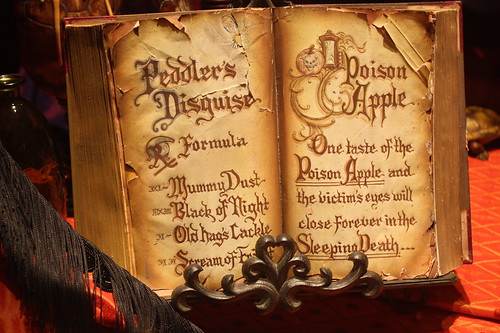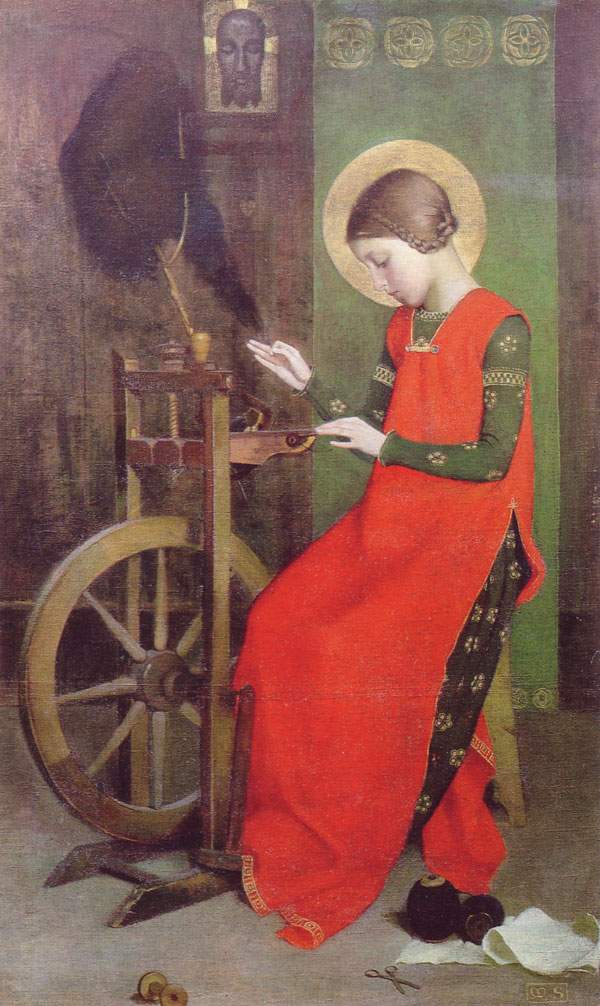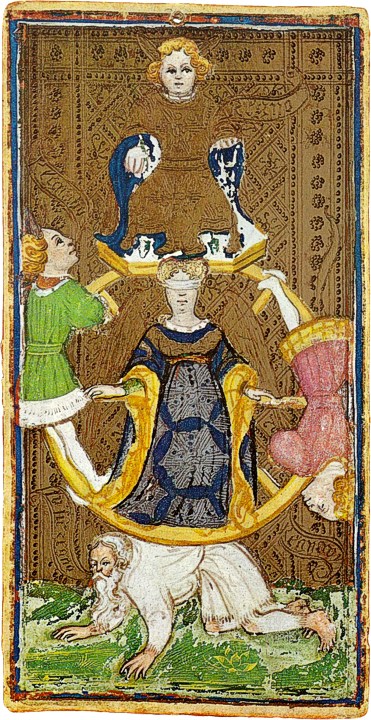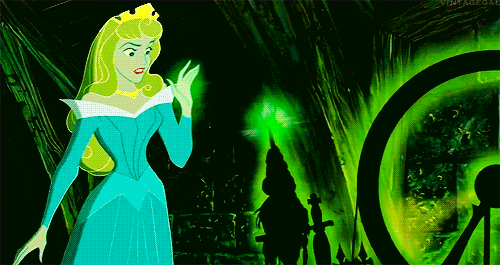 |
| Book as seen on Main Street USA, Disneyland CA |
'When she heard the looking-glass speak thus she trembled and shook with anger. "Snow-white shall die," cried she, "though it should cost me my own life!" And then she went to a secret lonely chamber, where no one was likely to come, and there she made a poisonous apple. It was beautiful to look upon, being white with red cheeks, so that any one who should see it must long for it, but whoever ate even a little bit of it must die.' ---The Brothers Grimm
 |
| Walt Disney's 'Snow White and the Seven Dwarves', 1937 |
The wicked Queen then disguises herself as an old peasant woman, having already appeared to the child in two different costumes(, perhaps this is where the idiom 'Third time's a charm' derives from.) She then makes her way back to Snow White to offer her an apple.
 |
| 'Snow White', Charles Santore |
"All right," answered the woman; "I can easily get rid of my apples elsewhere. There, I will give you one." "No," answered Snow-white, "I dare not take anything." "Are you afraid of poison?" said the woman, "look here, I will cut the apple in two pieces; you shall have the red side, I will have the white one." For the apple was so cunningly made, that all the poison was in the rosy half of it. Snow-white longed for the beautiful apple, and as she saw the peasant woman eating a piece of it she could no longer refrain, but stretched out her hand and took the poisoned half. But no sooner had she taken a morsel of it into her mouth than she fell to the earth as dead.' ---The Brothers Grimm
There are many peculiar notions here, one predominantly being the allusion to the biblical parable of Adam and Eve. Here the apple is split into two parts and the wicked Queen takes the first bite, and then Snow White falls after taking her bite. Fading into her Sleeping Death Snow White is allegorically experiencing the same plight of Adam and Eve. Beyond Looking Glasses and Spinning Wheels, apples appear in mythology all around the world transcending nearly every culture. In Greek mythology a golden apple is present when Aphrodite is determined to be the 'fairest' of all gods.
 |
| 'Mirror Mirror', Artwork by Douglas Smith, 2003 |
In a 2003 Novel titled Mirror Mirror, Gregory Maguire (, of Wicked fame,) explores the parallels to the eden myth in the 16th Century with Lucrezia Borgia painted as the wicked Queen. The apple in the tale is the believed to be from the 'Tree of Wisdom' in the 'Garden of Eden'. Although uncredited Maguire is really the first popular author to explore the reversal of roles. He is known for telling the side of tales you haven't heard. In the case of Mirror Mirror, he toys with the tradition in which Snow White is liberated from her curse, for it was the Huntsman's kiss that woke her. It was perhaps this very literary twist that inspired the 2012 Universal film titled: Snow White and the Huntsman, in which Snow White is awoken by the Huntsman's kiss.
 |
| Irish Elderly Spinner, Anonymous 1890-1900, Library of Congress Collection |
Of all the mysterious enchanted items in tales, the spindle or the spinning wheel is arguably the most eerie, for it is never described why the object is so dangerous or why it is so powerful. Perhaps it is more startling to women who could not escape the fate of spinning wool into thread for garments to wear. We must remember that these tales have been around for a great amount of time and when they were originally told people were closer to these experiences, such as peddlers knocking upon your door or needing to use a spinning wheel.
 |
| 'Thumb' by Marianne Stokes, 1894 |
The spinning wheel or the spindle make appearances in more than a few tales. Most famously the Sleeping Beauty is cursed by the Sleeping Death when she pricks her finger. In the tale of Rumpelstiltskin a spinning wheel is given to a poor Millers daughter after her father lies to the King, announcing that his daughter can spin straw into gold. Trapped within a cell the girl is told that if she can spin a heap of straw into gold she will be liberated. The girl is saved when she bargains with a malevolent imp that magically appears to her in the cell, bargaining for her first born child. In similar fashion three deformed women appear to a young girl when she is faced with a similar task in Grimm's tale The Three Spinners, the girl is saved when she makes a promise to invite the women to her royal wedding, socially transforming them into figures of nobility.
In the tale of Sleeping Beauty an infant princess is cursed at her Christening party. This plight occurs when one wise woman/fairy is not invited to the celebration. There are thirteen fairies and they can only eat from golden plates. When the King and Queen discover that there are only twelve plates, they decide that one woman must not be invited.
 |
| 'A Book of Fairy Tales' Janet and Anne Grahame Johnstone, 1977 |
'And when the eleventh of them had their say, in came the uninvited thirteenth, burning herself to revenge herself, and without greeting or respect, she cried with a loud voice, "In the fifteenth year of her age the Princess shall prick herself with a spindle and shall fall down dead." And without speaking one more word she turned away and left the hall. Every one was terrified at her saying, when the twelfth came forward, for she had not yet bestowed her gift, and though she could not do away with the evil prophesy, yet she could soften it, so she said, "The Princess shall not die, but fall into a deep sleep for a hundred years.' ---The Brothers Grimm
 |
| 'The Sleeping Beauty', Maxfield Parrish |
In one of the earliest variants of this tale (1634) Italian, Giambattista Basile's Sun, Moon and Talia. The Princess' fate is foretold by wise men and astrologers who predict the childs' fate at her birth, and her danger here is with a splinter of flax upon which she uses to spin, as opposed to the spindle itself. This is perhaps a more relatable circumstance, as most traditional spindles did not have a needle upon them. The curious thing about the Grimm version of the tale, is what virtue the Princess was missing as the wise fairy had to change her plans? It is arguably 'wisdom', as paradoxically that would be the very thing that would prevent her from touching a spindle.
A radical anthropological study published in 1987, by Chris Knight, Doctor of Philosophy, University College London, seeks a more physical truth behind familiar tales. In his thesis titled: Menstruation and the Origins of Culture he explores the metaphorical allegory in our most famous tales. In his essay he describes a pre Christian (Gregorian) calendar in which the moon was recognized in thirteen lunar months, as opposed to twelve.
"The menstrual spell is a cyclical occurrence, just as is seasonal change. Time, in the
traditional view, is itself cyclical. The king, in attempting to destroy all spindles, is
symbolically attempting to suppress the spinning by women of the threads of time –
threads which wind like yarn around a spool. We may also infer that he is hostile to
“spinsterhood”. A traditional occupation for unmarried or secluded women may have
been spinning, so that a woman who never married became seen as permanently a
“spinster”. Be that as it may, when the princess explores the unfamiliar stairway and
discovers the old witch spinning flax in her turret in the sky, she is contacting the
world of seclusion and discovering for herself the ancient feminine mistress of lunar
time. Like the thirteenth fairy, this old woman brings menstrual bleeding as a gift –
or, if socially-rejected, as a curse.
The girl “pricks her finger.” She bleeds, as any girl of her age eventually must. The King was foolish to try to banish the spinning-wheels or spindles, for time cannot be
suppressed – every girl will come of age and bleed, her cycle itself being among the
most ancient of all clocks. And as the princess bleeds, the ancient power of the blood
strikes out with a vengeance against all who had believed they could defy it. The
whole palace, the whole kingdom is plunged into another realm beyond waking life.
All normal domestic activities cease. It is as if time stood still. Those who believed
that they could alter the ancient calendar, they could abolish the thirteenth month,
they could suppress the hallowed logic of menstrual time are now put firmly in their
place. They will be excluded from time’s flow for a hundred years.
As the princess sleeps on, it is as if her blood had erected around her an impenetrable
barrier to her ever getting married. Would-be suitors are kept at bay by a deadly
hedge of thorns. She herself is now in menstrual seclusion of a particularly rigorous,
long-lasting kind, with the whole palace in seclusion with her.
But every period of seclusion – even a hundred-year one – must eventually expire. And when the time has come, lovers are free once more to approach. The spell breaks, the thorns turn into flowers. The hedge parts, allowing the young hero to enter and deliver his kiss. The sex-strike and the cooking-strike are over; the palace servants resume their domestic chores. Marital relations are resumed, and are celebrated in the palace with a royal wedding and feast." (Chris Knight, Doctor of Philosophy, University College London, 1987) You can read the full essay here.
Chris Knight's essay goes on further with other tales, in the case of Jack and the Beanstalk, Jack's exploration up the erect vine and to a giantess is metaphorically allegorical of his sexual awakening. The most curious thoughts we are led to in the tales of the spindle and the spinning wheel weave around issues of time, the spinning of the wheel itself is represented by time in passing. In the case of the Miller's daughter and Rumpelstiltskin, it took many years for the Princess to escape her promise to the wicked imp. In Sleeping Beauty, she lay in the state of sleeping death for one hundred years.
In the ancient medieval practice of Tarot reading, The Wheel of Fortune expresses the positive and negative dynamics of fate, and paradoxically it exists alongside minor arcana that bare the names King and Queen.
But every period of seclusion – even a hundred-year one – must eventually expire. And when the time has come, lovers are free once more to approach. The spell breaks, the thorns turn into flowers. The hedge parts, allowing the young hero to enter and deliver his kiss. The sex-strike and the cooking-strike are over; the palace servants resume their domestic chores. Marital relations are resumed, and are celebrated in the palace with a royal wedding and feast." (Chris Knight, Doctor of Philosophy, University College London, 1987) You can read the full essay here.
Chris Knight's essay goes on further with other tales, in the case of Jack and the Beanstalk, Jack's exploration up the erect vine and to a giantess is metaphorically allegorical of his sexual awakening. The most curious thoughts we are led to in the tales of the spindle and the spinning wheel weave around issues of time, the spinning of the wheel itself is represented by time in passing. In the case of the Miller's daughter and Rumpelstiltskin, it took many years for the Princess to escape her promise to the wicked imp. In Sleeping Beauty, she lay in the state of sleeping death for one hundred years.
 |
| Fortuna, as seen in European Iconography |
In the ancient medieval practice of Tarot reading, The Wheel of Fortune expresses the positive and negative dynamics of fate, and paradoxically it exists alongside minor arcana that bare the names King and Queen.
 |
| Visconti Tarot, 1450 |
Source Materials:
- Grimm's Complete Fairy Tales, Barnes and Noble Inc. 1993
- An Encyclopedia of Fairies, Katherine Briggs, Pantheon Books, New York, 1976
- The Sleeping Beauty: Illustrated by Arthur Rackham, Exter Books, 1972
- English Fairy Tales, Joseph Jacobs, first published in 1890, Every Man's: Library Children's Classics
- Mastering the Tarot, by Eden Gray, Signet Books 1971
- radicalanthropologygroup.org
- dictionary.com
- wikipedia.com

No comments:
Post a Comment